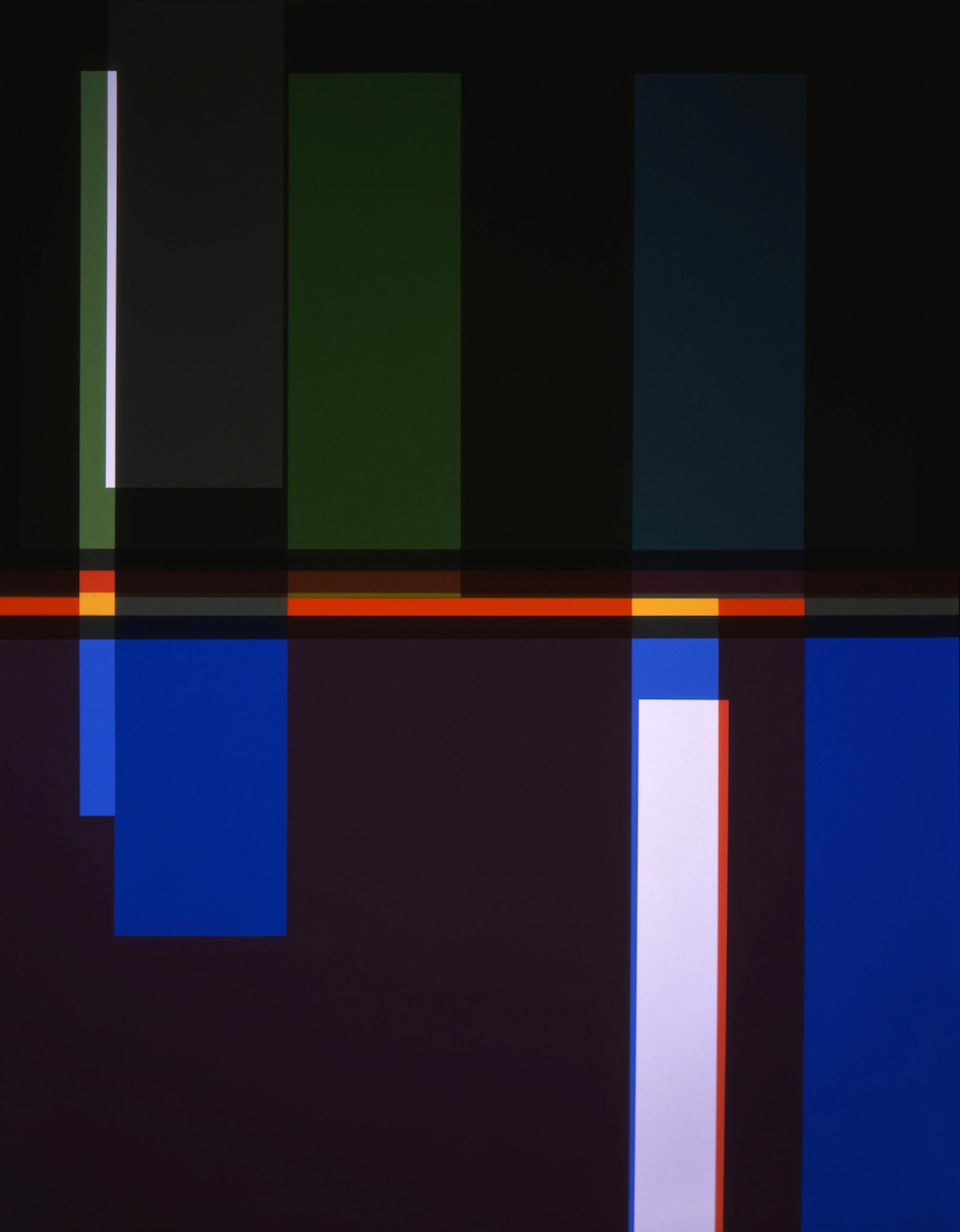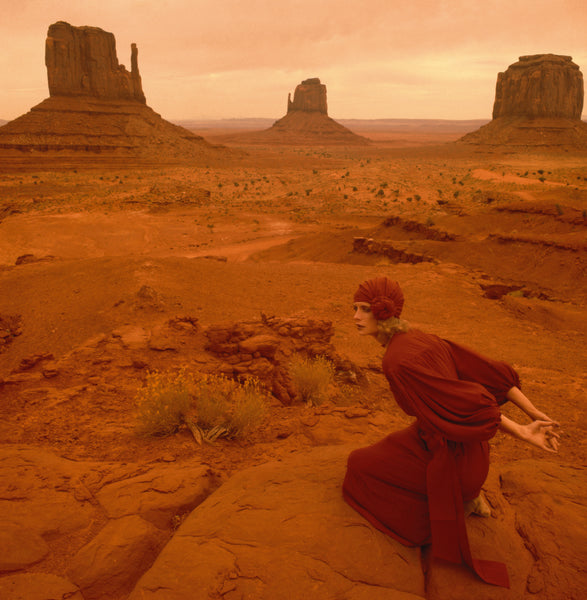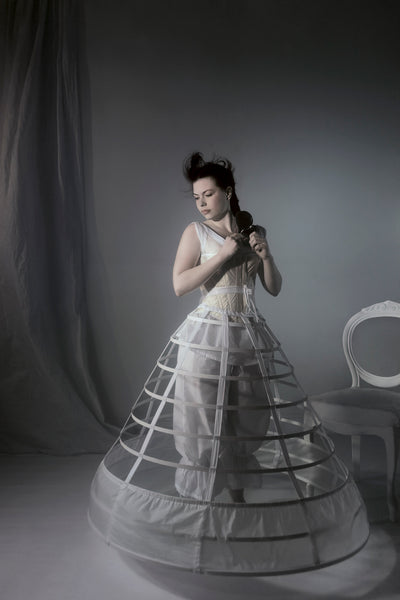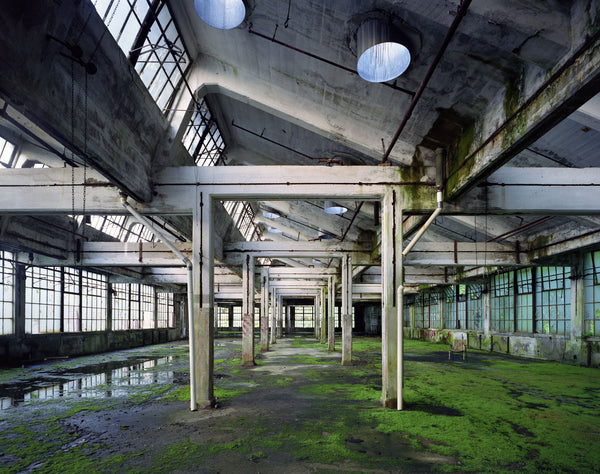
Seeing through modernism: transparency, absence and construction
Richard Caldicott | Seeing through modernism: transparency, absence and construction
By Derek Horton
"Tell me what that means. Or don't. No, don't." Don DeLillo 1
"Despite the fact the basis of this approach to art is in reason, its dynamic content is able to launch us on astral flights which soar into the unknown and still uncharted regions of the imagination." Max Bill 2
In a recent conversation, the artist Daniel Buren maintained that, "colour is the most interesting thing in art because it is the only thing you cannot speak about",3 and a contemporary writer has suggested that when discussing colour, "words tend to appear either too laboured or too breathless. Colour speaks silently for itself, and any attempt to speak on its behalf is bound to fail."4 It is with these warnings in mind that I embark on the task of using mere words to respond to the latest series of work by Richard Caldicott: photographs that resonate with chromatic intensity; in which compositional blocks of colour - sometimes vibrant and incandescent, sometimes cool and muted - define the juxtaposed rectilinear forms that interlock within a precise and rational geometric structure. Colours and forms are integrated to the point at which they become a single entity; a counterpoint of intense hues in which one form generates another in an overall equilibrium, sometimes bringing to mind compositional structures in music (another area where words can be woefully inadequate). Particularly in modernist composition, from Schoenberg and Varese to even more direct parallels in the music of the avant-garde American composers Conlon Nancarrow, John Cage and Morton Feldman, structural components, organised according to a rational system, transcend that order and attain evocative qualities and emotional intensities in a sound world that resonates beyond the boundaries of the architecture that generates it.5
There is a dialectic of restriction and freedom at play in the transcendent potential of such mathematical or geometric structures. Restricting visual perception to the simplicity of planes that define the boundaries of the framing rectangle by subdividing it into nothing other than further rectangles, the articulation of space is simple and 'empty' enough to throw viewers back on themselves, allowing room for solitude, space for silence, and the contemplation it invites. In this apparently 'deprived' space the viewer is freed to 'experience their own experience', their direct sensory and emotional response to optical signals of space and colour. "What these can yield us is something far transcending surface values since they not only embody form as beauty, but also form in which intuitions or ideas or conjectures have taken visible substance. .. And despite the fact the basis of this mathematical approach to art is in reason, its dynamic content is able to launch us on astral flights which soar into unknown and still uncharted regions of the imagination."6 So maintained the Swiss artist and designer, Max Bill, a key figure in the history of modernism.
In Caldicott's earlier works using Tupperware,7 what could be regarded as highly stylised photographs of a still-life 'subject' evolved into images from which the substance and identity of the photographed objects rapidly receded, emphasising the object-status of the photograph itself. This reduction to the essentials of an image that is practically abstract - and in which the depicted object is being abstracted from its context to the point where any reference to its nature or origin is erased - suggests that the photographic process, conventionally so linked to the reproduction of reality, is shifting towards the autonomous characteristics of 'non-objective' art. Caldicott has pursued this direction relentlessly, and in this new series of works the object as subject has disappeared altogether, leaving only what were formerly colour backgrounds arranged in abstract, geometric compositions that constitute autonomous objects in their own right. In several ways, though, it is important to recognise that such apparent abstraction does not necessarily constitute a subjective move away from materiality, physicality, or objectivity, but represents a shift to a different kind of reference to and representation of the material world.
In an important sense there can be no such thing as 'abstract photography' – what is recorded in a photograph, even if it is nothing but light (as in another sense it always is!) is an actually occurring physical phenomenon within a fixed period of time. It is significant that Caldicott refers to his latest works as 'constructions', a term that simultaneously suggests the manual making of things and a connection to constructivism and architecture. They are made in and of the material world and exist within it as objects. They are constructed using flat blocks of colour by means of a process equivalent to collage or assemblage; these are photographed and the resulting transparencies are superimposed to produce one image that
is printed as a photograph that is then mounted and framed in a very particular way as an autonomous object. I have described this process in some detail in order to emphasise that although these works might be described as 'abstract', a word that in the history of modernist art has often been synonymous with the 'non-objective', Caldicott remains fundamentally both a recorder and a maker of objects that exist in and refer to the material world. His work, incidentally, can clearly be seen to relate to Donald Judd's category of 'specific objects', holistic and unified artworks that are neither painting nor sculpture.8 Amongst the artworks to which Judd attached this term were Dan Flavin's fluorescent light sculptures, echoes of which are clearly evident in the thin strips of colour that punctuate - perhaps even 'illuminate' would not be too strong a word – many of Caldicott's Untitled Constructions.
Art is always inevitably in dialogue with itself; or, rather, artists are in dialogue with each other, whether contemporaneously or across decades or even centuries. The dialogue invited by Caldicott's art is clearly primarily with modernism in all its forms; not just with the 20th century tradition of abstract art, from Malevich and Mondrian to Minimalism, but also the open spaces, minimal simplicity and structured rationality associated with modernist architecture and music. This inter-relationship between art forms and disciplines, perhaps best exemplified by the ideals of the Bauhaus, is in itself a modernist principle founded on three basic ideas: "that art based on representation was associable with the old, destroyed pre-war order and should be replaced by a purely non-objective art, emblematic of the new age; that the new art would be both modern and useful by virtue of being composed of purified basic elements of form; and that its vocabulary of basic elements could be used to construct virtually any kind of fabricated object, thus making it possible to dissolve the boundaries between the individual arts, and between them and everyday life." 9
The architectonic aspects of Caldicott's Untitled Constructions demonstrate a clear awareness of and identification with the structure and aesthetics of modernist architecture in their definition of space through flat blocks of autonomous colour that never merge or modulate, relating to each other only by steps, edges or boundaries yet creating a continuity of form, an actual, material space; an object rather than an imagined world. Caldicott acknowledges a specific relationship to the architect RM Schindler's concept of 'space architecture', defined by Schindler as a fundamental concern with "the creation of space forms"10 in which " the only idea is space and its organisation [and] form no longer symbolises the constructional play of forces; the construction itself becomes form." 11
Colour-field painting from the 1950's to the 1970's (the work of Max Bill, Josef Albers, Richard Lohse, Burgoyne Diller, David Novros and John McLaughlin for example), evidenced not only an aesthetic of rationalism, order, structure and uniformity but the use of industrial techniques and materials in its paints, finishes and supports; materials with visual qualities in and of themselves, sometimes requiring minimal intervention in the studio. These created objectified rather than atmospheric colours and an art that was artificial, urban and industrial. Clearly Caldicott's work, with its stringent aesthetics, rigorous sensibility and intellectual discipline, is directly related it to this particular form of modernist abstraction, but it also maintains a difference and distance from it, not least in its means of production - not only are these works photographic prints but photography is central to their whole process of construction. In colour-field painting the structure of geometric abstraction emphasises the wholeness of the pictorial field, a tensely frontal compositional plane bearing a holistic composition with the surface of the picture treated as if it were a single unit – a Caldicott photograph is one!
Another significant aspect of Caldicott's means of production is the dualism of physicality and abstraction that is inherent in the construction of these works by means of transparency: what appear as solid blocks of opaque colour in the final works are actually created by the manipulation of transparent colour. Hence each block of colour is not just a surface but an aperture or window, opening up a space beyond its geometric and structural boundaries. A dialectic of alternating surface and depth is set up by the way in which the solid opaque object has been created by the passage of light through transparent surfaces. Here again there are relationships to modernist architecture: RM Schindler's pioneering 'space architecture'12 aimed to reduce solid building materials to the bare minimum in his aspiration to create 'translucent houses', a concept that reached its epitome in Pierre Koenig's iconic Stahl House,13 identified by Norman Foster as having " long been a touchstone for contemporary architects".14
The logic of modernism, Ad Reinhardt argued, was a constant striving to make art "purer and emptier",15 pursuing what his lesser known contemporary, the English artist and theorist Anthony Hill, called "an aesthetic of objective invention and sensation, distinctly rational and determinist" and "not undermined with latent associations".16 Rosalind Krauss has identified the grid as emblematic of modernist ambition in the visual arts, arguing that it "states the autonomy of the realm of art. Flattened, geometricised, ordered, it is antinatural, antimimetic, antireal. It is what art looks like when it turns its back on nature." In a picture based on a grid structure, "the physical qualities of the surface .. are mapped onto the aesthetic dimensions of the same surface. And those two planes – the physical and the aesthetic – are demonstrated to be the
same plane: .. the bottom line of the grid is a naked and determined materialism."17 Krauss also identifies the dialectical aspect of 'within-the-frame grids' and 'beyond-the-frame grids', the way that they simultaneously define the rectilinear borders of the image and imply the infinite possible extension of the image beyond them.
Despite the gridded architectural framework that defines their structure, the spatial and chromatic variation of Caldicott's Untitled Constructions are not based on a priori rules or a systematically ordered schema, but are the result of continual choices, sometimes perhaps between accidents or fortuitous occurences. As Donald Judd observed, "freedom and indeterminacy are antecedents to and larger than order. .. [There is an order that] is not one of control or distillation, but of continual choice. .. An activity proliferates its own distinctions: an order forms within these." 18 Caldicott's process results in just such a proliferation of possibilities between which distinctions are made and order forms. Such an approach is not a descent into subjectivity and aesthetic capriciousness but, on the contrary, a different perspective on objectivity and materiality. As Lynne Cooke has observed, "different notions of order, neither rational nor irrational but something closer to an absence of conventional order have recently occupied many scientists working in different fields, and using different discourses. .. Order has become demonstrably relative, if not relational. The concrete and the actual are revealed to be dependent on the provisional, .. intertwined with contingency [and] relativity." 19
Historically, modernism represented the search for an expressive form that could answer the requirements of a new industrialised society and its mass culture, founded on a utopian philosophy in which art and design was meant to construct a new world, or at least form the blueprint for one. Following the disillusionments of the 1930's and later setbacks, modernism inevitably lost some of its ideological certainties and utopian ambitions. But its aesthetic form survived strongly: in over a century of modern art the history of geometric abstract painting has been a remarkably resilient one, and the idea of composing from basic elements using systematically organised abstract relations of colour, line and form, modular geometric structure and spatial definition based on topographical and mathematical principles (perhaps in part because of its resonance with our urban experience through its closeness to architecture) has been a continuing thread in visual art that has its latest manifestation in Caldicott's series of Untitled Constructions.
For its maker and viewers alike, Caldicott's art involves looking back to constructivist art and modernist design, referencing its purity of form and, by indirect allusion at least, its utopian agenda. Revisiting such ideas at this distance in time inevitably involves a psychic and conceptual separation from their values and ideological motivations - their strategies are
part of a constellation of ideas and images that are difficult now to reference, utilise or manipulate without some degree of irony. Whilst his work may suggest that Caldicott is an 'unreconstructed modernist', it is arguable that it is impossible now to make work 'as' a modernist - one can only refer to modernism or, to use a term beloved of postmodern theorists, 'cite' it. For much postmodern art such citation relies on pastiche that critiques or even lampoons modernism and its values, but for some artists of Caldicott's generation, who grew up artistically in the 1980's and were exposed to postmodern pastiche at its peak, it is possible now to look back to modernism from a different perspective, to be outside it but remain in many ways respectful or admiring of it.20 To return to the forms and appearances of twentieth-century modernism is to look back to something that itself was fundamentally about looking forward - to a utopian future, a rational and ordered social and aesthetic model for living, that was never fully (and certainly not, as it had hoped, universally) realised. In this sense there are possible nostalgic readings of Caldicott's modernist-influenced work - not necessarily nostalgia for the form of modernist utopian ideals, but for the very perception of such a possibility in the past; nostalgia for the belief that a utopia might be possible at all.
Notes
1. A fragment of dialogue from Don DeLillo's latest novel, Cosmopolis, London: Picador, 2003 (p.72)2. Max Bill, The Mathematical Approach in Contemporary Art, first published 1949, reprinted in Eduard Huttinger, Max Bill, Zurich: ABC Editions, 1978 (p.116)
3. Daniel Buren, in conversation with the author, Los Angeles, 8 April 2003.
4. David Batchelor, Chromophobia, London: Reaktion Books, 2000 (p.98)
5. Whilst one might 'hear' Feldman or Cage in some of the more subtle and muted of Caldicott's Untitled Constructions (Nos. 7, 10, or 11, for example) the freedom and abandon of the incandescent colour interplay in others (such as Nos. 3, 5 or 8) perhaps has a closer musical parallel in Albert Ayler's soaring and wailing improvisations within the tight framework of simple hymns and folk tunes.
6. Max Bill, in Huttinger, 1978, op cit. (pp.114-6)
7. See, for instance, the exhibition catalogues: Richard Caldicott, New Work, London: Hamiltons, 2002; and Optic Nerve, Ipswich: Ipswich Borough Council, 2003
8. Donald Judd, first published 1965, reprinted in Donald Judd, Complete Writings, 1959-1975, Halifax: The Press of Nova Scotia Art and Design, 1975 (pp.181-9)
9. John Elderfield, in Magdalena Dabrowski, Contrasts of Form: Geometric Abstract Art 1910-1980, New York: The Museum of Modern Art, 1985 (p.11)
10. RM Schindler, Space Architecture, in Dune Forum, February 1934
11. from RM Schindler's Modern Architecture – A Program (1913), this extract is from the new translation of Schindler's original manuscript in Lionel March & Judith Sheine [eds.], RM Schindler: Composition and Construction, London: Academy Editions, 1995 (pp.10,11)
12. See note 9 above.
13. Pierre Koenig's Stahl House, 1960, also known as Case Study House #22, is amply illustrated in James Steele & David Jenkins, Pierre Koenig, London: Phaidon Press, 1998 (pp.60-71). I am grateful to my friend and colleague Chris Bloor for drawing my attention to its relevance in this context, and for his other insightful observations that have informed the writing of this essay.
14. Norman Foster, Introduction, Steele & Jenkins, 1998, op cit. (p.5)
15. Ad Reinhardt, Twelve Rules for a New Academy, first published 1957, reprinted in Barbara Rose [ed.], The Selected Writings of Ad Reinhardt, Berkeley: University of California Press, 1991 (pp.203-7)
16. Anthony Hill, An Introductory Note on Concrete Art (1952) and Nine Abstract Artists (1954), cited in the Hayward Gallery exhibition catalogue, Anthony Hill: A Retrospective Exhibition, London, Arts Council of Great Britain, 1983 (p.8). Although space does not permit discussion of them here, it is important to note the problems and contradictions inherent in this ideology: there are plenty of associations, latent or otherwise, with the idea of 'purity'!
17. Rosalind Krauss, Grids, in October, no.9 (Summer 1979), reprinted in Rosalind Krauss, The Originality of the Avant Garde and Other Modernist Myths, Cambridge, Massachusetts: MIT Press, 1985 (pp.9-22)
18. Donald Judd, Chamberlain: Another View (1963-1964), reprinted in Judd, 1975, op cit. (pp.109-110)
19. Lynne Cooke, Donald Judd: Re-ordering Order, in the exhibition catalogue, Donald Judd, London: Waddington Galleries, 1989 (p.8)
20. A recent example of a much more ironic contemporary referencing or citing of modernist art can be found, for example, in the work of Jeff McMillan, Armando Andrade Tudela and Jefford Horrigan, recently shown together in Retriever at Pearl, London, and reviewed by Mark Godfrey in Frieze, Issue 80, Jan/Feb 2004 (pp.107-8)
© Derek Horton: published in Richard Caldicott, New Work, Hamiltons, London, 2004. ISBN 0-9547257-0-0



